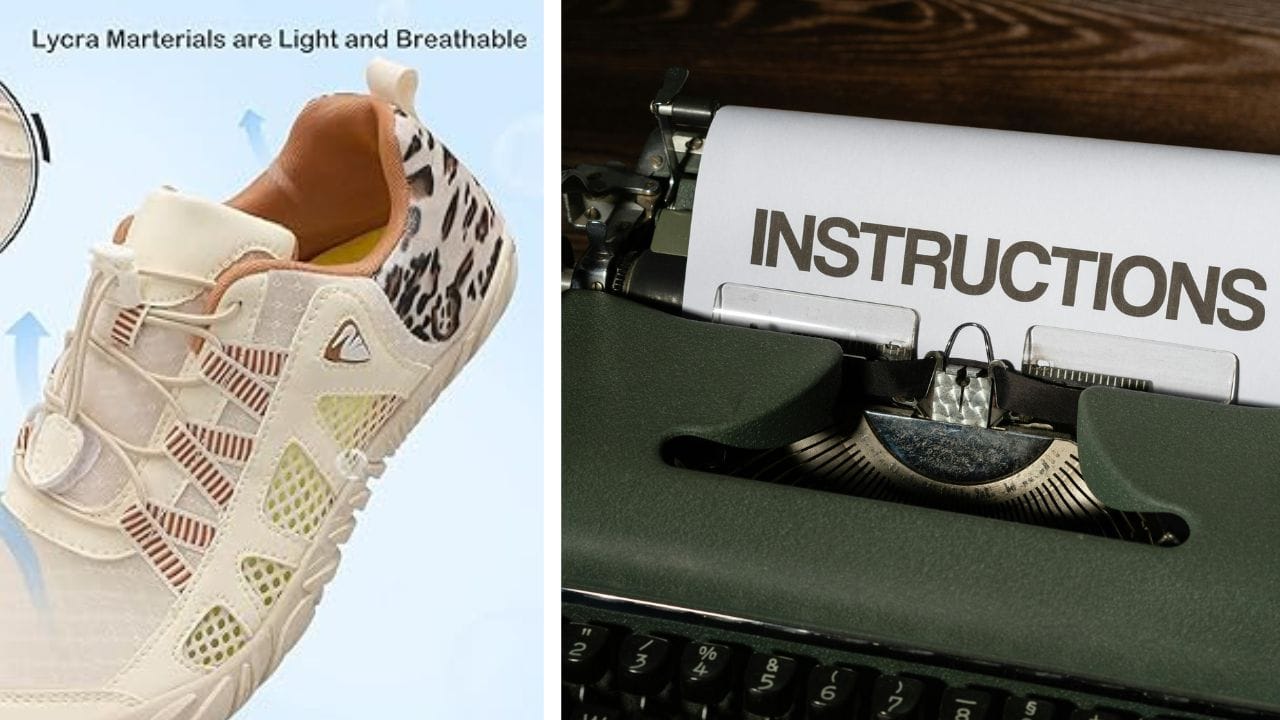How to Care for Your Barefoot Shoes: A Comprehensive Guide
Caring for your barefoot shoes is essential to maintain their performance and longevity.

Key Takeaways:
- Proper cleaning and maintenance extend the life of your barefoot shoes.
- Regular inspections help identify wear and tear early.
- Storing barefoot shoes correctly prevents damage and maintains their shape.
Introduction to Barefoot Shoes
Barefoot shoes have taken the footwear market by storm, offering a minimalist design that promotes natural foot movement. These shoes are designed to mimic the feeling of walking barefoot while providing protection from the elements. However, like any other footwear, they require proper care to ensure longevity and performance.
Why Proper Care is Essential
Taking care of your barefoot shoes is crucial for maintaining their functionality and extending their lifespan. Neglecting them can lead to premature wear and tear, reducing their effectiveness and comfort. Proper care involves regular cleaning, inspections, and correct storage practices.
Cleaning Your Barefoot Shoes
Daily Cleaning Routine
After each use, it's essential to remove any dirt or debris from your barefoot shoes. Use a soft brush or cloth to wipe away any surface dirt. This simple step can prevent the buildup of grime that can damage the material over time.
Deep Cleaning
For a more thorough clean, remove the insoles and laces. Hand wash the shoes using mild soap and lukewarm water. Avoid using harsh chemicals or putting them in the washing machine, as this can damage the material and structure of the shoes.
Drying Your Barefoot Shoes
Air Drying
After cleaning, it's crucial to dry your barefoot shoes properly. Air drying is the best method. Stuff the shoes with newspaper or a towel to help them retain their shape and absorb excess moisture. Place them in a well-ventilated area away from direct sunlight or heat sources.
Avoiding Heat
Never use a dryer or place your barefoot shoes near a heater. Excessive heat can warp the material and compromise the shoe's structure. Patience is key; allow them to dry naturally to maintain their integrity.
Inspecting for Wear and Tear
Regular Inspections
Regularly inspect your barefoot shoes for signs of wear and tear. Check the soles for thinning or uneven wear, and examine the upper material for any tears or weak spots. Early detection of issues can prevent further damage and extend the life of your shoes.
Addressing Issues
If you notice any problems, address them immediately. Small tears can often be repaired with a strong adhesive, while more significant issues may require professional repair. Ignoring these problems can lead to more extensive damage and reduce the effectiveness of your barefoot shoes.
Storing Your Barefoot Shoes
Proper Storage
When not in use, store your barefoot shoes in a cool, dry place. Avoid leaving them in damp or humid environments, as this can lead to mold and mildew growth. Use a shoe tree or stuff them with newspaper to help maintain their shape.
Travel Tips
If you're traveling with your barefoot shoes, pack them in a breathable bag to protect them from dirt and damage. Avoid squishing them in tight spaces, as this can deform the shoes and affect their performance.
Rotating Your Footwear
Benefits of Rotation
Rotating your barefoot shoes with other pairs can significantly extend their lifespan. Giving each pair time to rest and recover between uses allows the materials to decompress and reduces the risk of overuse damage.
Building a Rotation
Consider building a rotation of barefoot shoes for different activities. For example, have a pair for running, another for casual wear, and a third for hiking. This approach ensures that each pair gets adequate rest and remains in good condition.
Using the Right Socks
Importance of Socks
Wearing the right socks with your barefoot shoes can enhance comfort and prevent blisters. Opt for moisture-wicking socks that keep your feet dry and reduce friction. Avoid cotton socks, as they tend to retain moisture and can lead to discomfort.
Sock Maintenance
Just like your barefoot shoes, your socks need proper care. Wash them regularly and replace them when they show signs of wear. Keeping your socks in good condition ensures that your barefoot shoes remain comfortable and effective.
Avoiding Common Mistakes
Overuse
One common mistake is overusing a single pair of barefoot shoes. This can lead to accelerated wear and tear. Rotate your shoes and give them time to rest between uses to maintain their longevity.
Ignoring Maintenance
Neglecting regular maintenance can shorten the lifespan of your barefoot shoes. Make cleaning, inspections, and proper storage a routine to keep your shoes in top condition.
Enhancing Durability
Protective Sprays
Consider using a protective spray designed for barefoot shoes. These sprays can create a barrier against dirt and water, helping to keep your shoes clean and dry. Follow the manufacturer's instructions for the best results.
Reinforcing Weak Spots
If you notice any weak spots in your barefoot shoes, reinforce them with a strong adhesive or take them to a professional for repair. Addressing these issues early can prevent more significant damage and extend the life of your shoes.
Understanding Material Types
Different Materials
Barefoot shoes come in various materials, each with its care requirements. Common materials include leather, synthetic fabrics, and mesh. Understanding the specific needs of each material can help you provide the best care for your shoes.
Material-Specific Care
Leather barefoot shoes may require conditioning to keep the material supple, while synthetic fabrics might need special cleaning solutions. Research the care instructions for your specific shoe material to ensure you're providing the best care.
Benefits of Proper Care
Longevity
Proper care can significantly extend the lifespan of your barefoot shoes. Regular cleaning, inspections, and correct storage practices ensure that your shoes remain in good condition for longer, saving you money in the long run.
Performance
Well-maintained barefoot shoes perform better. Clean shoes provide better traction, while shoes in good condition offer the support and protection you need. Proper care ensures that your barefoot shoes continue to deliver the benefits they were designed for.
Eco-Friendly Practices
Sustainable Cleaning
Opt for eco-friendly cleaning solutions when caring for your barefoot shoes. Avoid harsh chemicals that can harm the environment and choose biodegradable soaps and detergents. This approach is better for the planet and your shoes.
Recycling Old Shoes
When your barefoot shoes reach the end of their life, consider recycling them. Many companies offer recycling programs for old shoes, ensuring that they don't end up in a landfill. This practice supports sustainability and reduces waste.
Common Myths Debunked
Myth: Barefoot Shoes Don't Need Care
Some people believe that barefoot shoes don't require care because of their minimalist design. This is a misconception. Proper care is essential for maintaining the functionality and longevity of barefoot shoes, just like any other footwear.
Myth: Machine Washing is Safe
Another common myth is that it's safe to machine wash barefoot shoes. While it might be convenient, machine washing can damage the material and structure of the shoes. Hand washing is the best method to ensure your shoes remain in good condition.
Expert Tips
Professional Advice
Consulting with experts can provide valuable insights into caring for your barefoot shoes. Many manufacturers offer care guides and tips on their websites. Following these recommendations can help you maintain your shoes effectively.
Community Insights
Joining online communities or forums dedicated to barefoot shoes can also be beneficial. These platforms offer a wealth of knowledge from fellow barefoot shoe enthusiasts who share their experiences and tips for proper care.
Conclusion
Caring for your barefoot shoes doesn't have to be a chore. With regular cleaning, inspections, and proper storage, you can ensure that your shoes remain in excellent condition for years to come. By following these tips and incorporating them into your routine, you'll enjoy the benefits of barefoot shoes while maximizing their lifespan.
Summary
Proper care for barefoot shoes involves regular cleaning, inspections, and correct storage practices. By following these guidelines, you can extend the life of your shoes and maintain their performance. Remember to rotate your footwear, use the right socks, and avoid common mistakes to keep your barefoot shoes in top condition.
If you are looking to get some more barefoot shoes and are undecided then click the button below to see which barefoot shoes that we have selected for you to try.

